The Use of an Unmanned Aerial Vehicle for Tree Phenotyping Studies
Abstract
:1. Introduction
2. Methodology and Apparatus
2.1. Sampling Site
2.2. Unmanned Aerial Vehicle
2.3. UAV Data Analysis: Photogrammetric Processing
2.4. Field Data Analysis
2.5. Image Processing and Data Analysis
2.6. Principal Component Analysis Applied to Obtained Data
2.7. K-Means Segmentation and Quantification of Invasive Tree Species
3. Results and Discussion
3.1. Evaluating the Performance of PCA and K-Means Segmentation in Classifying Non-Native Tree Species
3.2. Quantitative Information Obtained by Analysis of UAV MSI and Field Study Data
4. Conclusions
Author Contributions
Funding
Acknowledgments
Conflicts of Interest
References
- Cooper, N.S. How natural is nature reserve? An ideological study of British nature conservation landscapes. Biodivers. Conserv. 2000, 9, 1131–1152. [Google Scholar] [CrossRef]
- Papp, L.; Leeuwen, B.; Szilassi, P.; Tobak, Z.; Szatmari, J.; Àrvai, M.; Meszaros, J.; Pàsztor, L. Monitoring Invasive plant species using hyperspectral remote sensing data. Land 2021, 10, 29. [Google Scholar] [CrossRef]
- Tobin, P.C. Managing invasive species. F1000Research 2018, 7, 1–18. [Google Scholar] [CrossRef] [Green Version]
- Drechsler, M.; Touza, J.; White, P.C.L.; Jones, G. Agricultural landscape structure and invasive species the cost-effective level of crop field clustering. Food Secur. 2016, 8, 111–121. [Google Scholar] [CrossRef]
- Atkinson, S.; Townsend, M. The State of the UK’s Forests, Woods and Trees. Woodl. Trust Grantham Lincs. 2011, 1–100. Available online: https://issuu.com/piro.co.uk/docs/state-of-the-uks-forest-report-woodland-trust (accessed on 13 November 2020).
- A Brief History of Woodlands in Britain. Conservation Handbook. Available online: https://www.conservationhandbooks.com/woodlands/a-brief-history-of-woodlands-in-britain/ (accessed on 13 November 2020).
- Woodland Trust. Ancient Woodland. Available online: https://www.woodlandtrust.org.uk/trees-woods-and-wildlife/habitats/ancient-woodland/ (accessed on 17 September 2021).
- Pryor, S.N.; Smith, S. The Area and Composition of Plantations on Ancient Woodland Sites. 2002. Available online: http://www.woodlandtrust.org.uk/en/why-woods-matter/restoring/restoration-research/Pages/research.aspx#.Ul1RDyRKDfQ (accessed on 23 August 2021).
- Managing Ancient and Native Woodland in England. Forestry Commission (England). Available online: https://www.forestresearch.gov.uk/research/managing-ancient-and-native-woodland-in-england/ (accessed on 12 November 2020).
- Tehrany, M.S.; Kumar, L.; Drielsma, M.J. Review of native vegetation conditions assessment concepts, methods and future trends. J. Nat. Conserv. 2017, 40, 12–23. [Google Scholar] [CrossRef]
- Mafanya, M.; Tsele, P.; Botai, J.; Manyama, P.; Swart, B.; Monate, T. Evaluation pixel and object based image classification techniques for mapping plant invasions from UAV derived aerial imagery: Harrisia pomanensis as a case study. ISPRS J. Photogramm. Remote Sens. 2017, 129, 1–11. [Google Scholar] [CrossRef] [Green Version]
- Leslie, R.V. Microwave sensors. Compr. Remote Sens. 2018, 1, 435–474. [Google Scholar]
- Huang, C.; Asner, G.P. Applications of remote sensing to alien invasive plant studies. Sensors 2009, 9, 4869–4889. [Google Scholar] [CrossRef] [Green Version]
- Bradley, B.A.; Mustard, J.F. Characterizing the landscape dynamics of an invasive plant and risk of invasion using remote sensing. Ecol. Appl. 2006, 16, 1132–1147. [Google Scholar] [CrossRef] [Green Version]
- Vilà, M.; Espinar, J.L.; Hejda, M.; Hulme, P.E.; Jarošík, V.; Maron, J.L.; Pergl, J.; Schaffner, U.; Sun, Y.; Pysek, P. Ecological impacts of invasive alien plants: A meta-analysis of their effects on species, communities and ecosystems. Ecol. Lett. 2011, 14, 702–708. [Google Scholar] [CrossRef]
- Lantz, N.J.; Wang, J. Object-based classification of Worldview-2 imagery for mapping invasive common reed, Phragmites australis. Can. J. Remote Sens. 2013, 39, 328–340. [Google Scholar] [CrossRef]
- Khare, S.; Latifi, H.; Ghosh, S.K. Multi-scale assessment of invasive plant species diversity using Pléiades 1A, RapidEye and Landsat-8 data. Geocarto Int. 2017, 33, 681–698. [Google Scholar] [CrossRef]
- Ng, W.T.; Rima, P.; Einzmann, K.; Immitzer, M.; Atzberger, C.; Eckert, S. Assessing the Potential of Sentinel-2 and Pléiades Data for the Detection of Prosopis and Vachellia spp. in Kenya. Remote Sens. 2017, 9, 74. [Google Scholar] [CrossRef] [Green Version]
- Lehmann, J.R.K.; Prinz, T.; Ziller, S.R.; Thiele, J.; Heringer, G.; Meira-Neto, J.A.A.; Buttschardt, T.K. Open-source processing and analysis of aerial imagery acquired with a low-cost unmanned aerial system to support invasive plant management. Front. Environ. Sci. 2017, 5, 1–16. [Google Scholar] [CrossRef] [Green Version]
- Mirik, M.; Chaudhuri, S.; Surber, B.; Ale, S.; James Ansley, R. Detection of two intermixed invasive woody species using color infrared aerial imagery and the support vector machine classifier. Int. J. Remote Sens. 2013, 7, 073588. [Google Scholar] [CrossRef] [Green Version]
- Mirik, M.; Ansley, R.J.; Steddom, K.; Jones, D.C.; Rush, C.M.; Michels, G.J.; Elliott, N.C. Remote Distinction of A Noxious Weed (Musk Thistle: CarduusNutans) Using Airborne Hyperspectral Imagery and the Support Vector Machine Classifier. Remote Sens. 2013, 5, 612–630. [Google Scholar] [CrossRef] [Green Version]
- Dronova, I.; Spotswood, E.N.; Suding, K.N. Opportunities and Constraints in Characterizing Landscape Distribution of an Invasive Grass from Very High Resolution Multi-Spectral Imagery. Front. Plant Sci. 2017, 8, 890. [Google Scholar] [CrossRef] [Green Version]
- Skowronek, S.; Ewald, M.; Isermann, M.; Kerchove, R.V.D.; Lenoir, J.; Aerts, R.; Warrie, J.; Hattab, T.; Honnay, O.; Schmidtlein, S.; et al. Mapping an invasive bryophyte species using hyperspectral remote sensing data. Biol. Invasions 2017, 19, 239–254. [Google Scholar] [CrossRef]
- Dash, J.P.; Watt, M.S.; Paul, T.S.H.; Morgenroth, J.; Pearse, G.D. Early detection of invasive exotic trees using UAV and manned aircraft multispectral and LiDAR data. Remote Sens. 2019, 11, 1812. [Google Scholar] [CrossRef] [Green Version]
- Dvořák, P.; Müllerová, J.; Bartaloš, T.; Bruna, J. Unmanned aerial vehicles for alien plant species detection and monitoring. Int. Arch. Photogramm. Remote Sens. Spat. Inf. Sci. 2015, 1, 83–90. [Google Scholar] [CrossRef] [Green Version]
- Lishawa, S.C.; Carson, B.D.; Brandt, J.S.; Tallant, J.M.; Reo, N.J.; Albert, D.A.; Monks, A.M.; Lautenbach, J.M.; Clark, E. Mechanical Harvesting Effectively Controls Young Typha spp. Invasion and Unmanned Aerial Vehicle Data Enhances Post-treatment Monitoring. Front. Plant Sci. 2017, 8, 619. [Google Scholar] [CrossRef]
- Perroy, R.L.; Sullivan, T.; Stephenson, N. Assessing the impacts of canopy openness and flight parameters on detecting a sub-canopy tropical invasive plant using a small unmanned aerial system. ISPRS J. Photogramm. Remote Sens. 2017, 125, 174–183. [Google Scholar] [CrossRef]
- De Sá, N.C.; Castro, P.; Carvalho, S.; Marchante, E.; López-Núñez, F.A.; Marchante, H. Mapping the Flowering of an Invasive Plant Using Unmanned Aerial Vehicles: Is There Potential for Biocontrol Monitoring? Front. Plant Sci. 2018, 9, 1–13. [Google Scholar] [CrossRef] [PubMed] [Green Version]
- Martin, F.M.; Müllerová, J.; Borgniet, L.; Dommanget, F.; Breton, V.; Evette, A. Using Single- and Multi-Date UAV and Satellite Imagery to Accurately Monitor Invasive Knotweed Species. Remote Sens. 2018, 10, 1662. [Google Scholar] [CrossRef] [Green Version]
- Lopatin, J.; Dolos, K.; Kattenborn, T.; Fassnacht, F.E. How canopy shadow affects invasive plant species classification in high spatial resolution remote sensing. Remote. Sens. Ecol. Conserv. 2019, 5, 302–317. [Google Scholar] [CrossRef]
- Santo, R.F. Principal component analysis applied to digital image compression. Einstein 2012, 2, 135–139. [Google Scholar] [CrossRef] [Green Version]
- Priestclose Wood. Northumberland Wildlife Trust. Available online: https://www.nwt.org.uk/nature-reserves/priestclose-wood (accessed on 12 November 2020).
- Northumberland County Council. Northumberland Local Plan. Core Strategy, Green Belt Review 2015, and update 2018. Prudhoe LPA label PE11a, Priestclose Wood. Available online: https://www.northumberland.gov.uk/NorthumberlandCountyCouncil/media/Planning-and-Building/planning%20policy/Local%20Plan/Green-Belt-Technical-Paper-December-2018-Final.pdf (accessed on 12 December 2020).
- Northumberland County Council Planning Application: 14/04160/FUL|Development comprising the demolition of non-listed buildings, erection of 392 dwellings (Use Class C3), conversion of Prudhoe Hall and associated buildings to provide 12 dwellings (Use Class C3), improvement works to Walled Garden and associated access, landscape and infrastructure. |Former Prudhoe Hospital Prudhoe Hospital Drive Prudhoe Northumberland NE42 5NT. Available online: https://publicaccess.northumberland.gov.uk/online-applications/ (accessed on 17 September 2021).
- Shan, P. Image segmentation method based on K-mean algorithm. J. Image Video Process. 2018, 81, 2–9. [Google Scholar] [CrossRef]


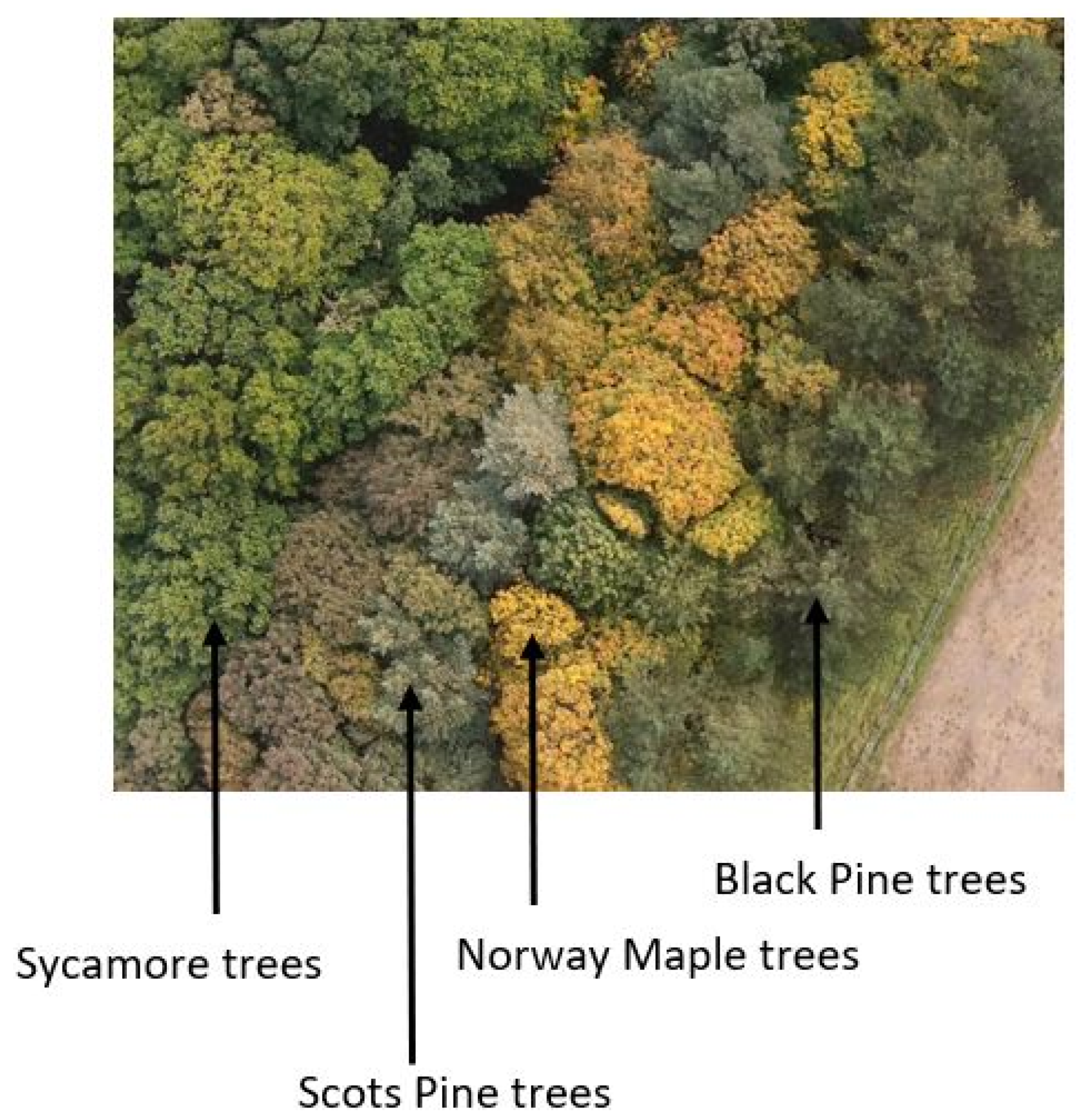

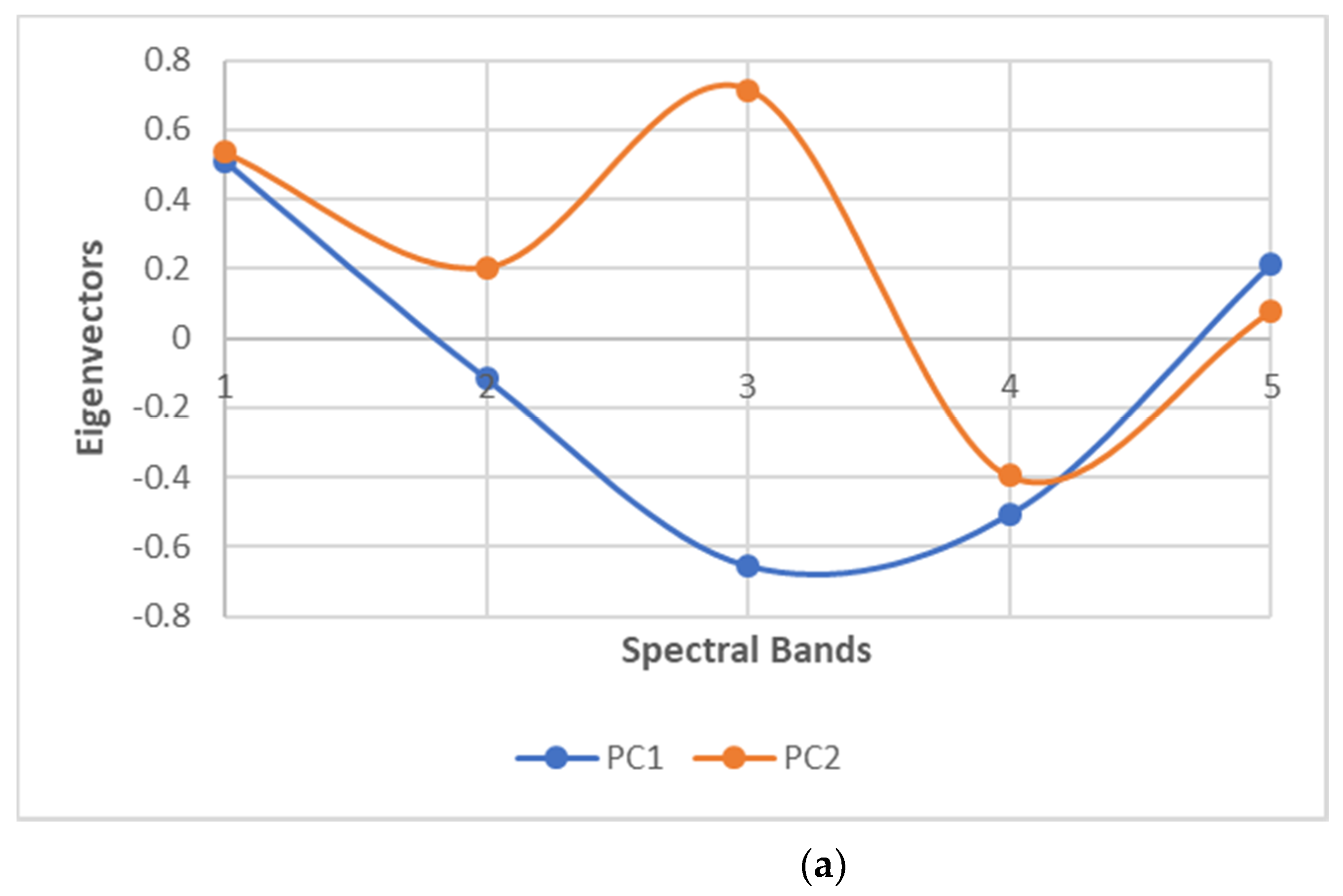
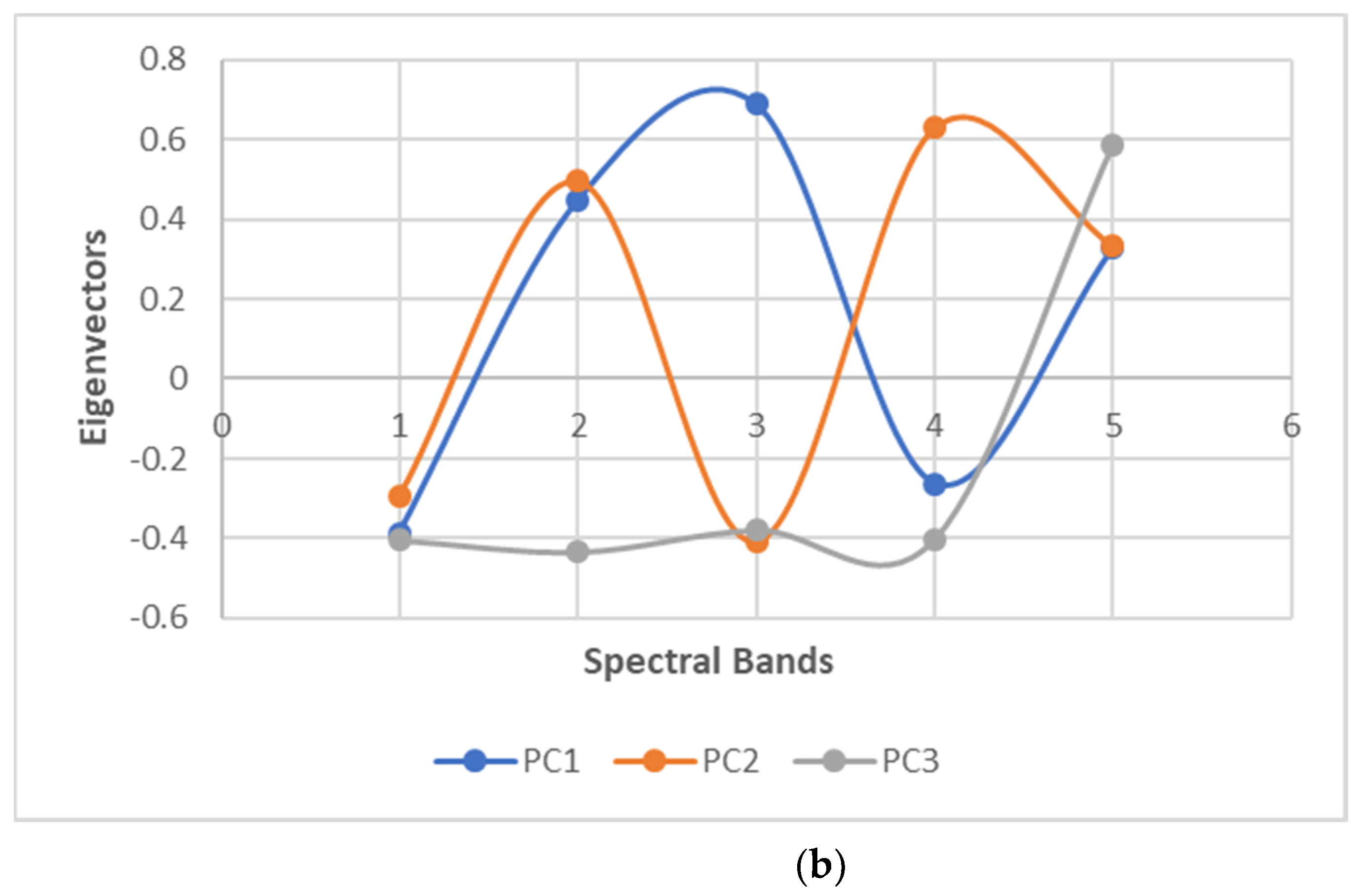
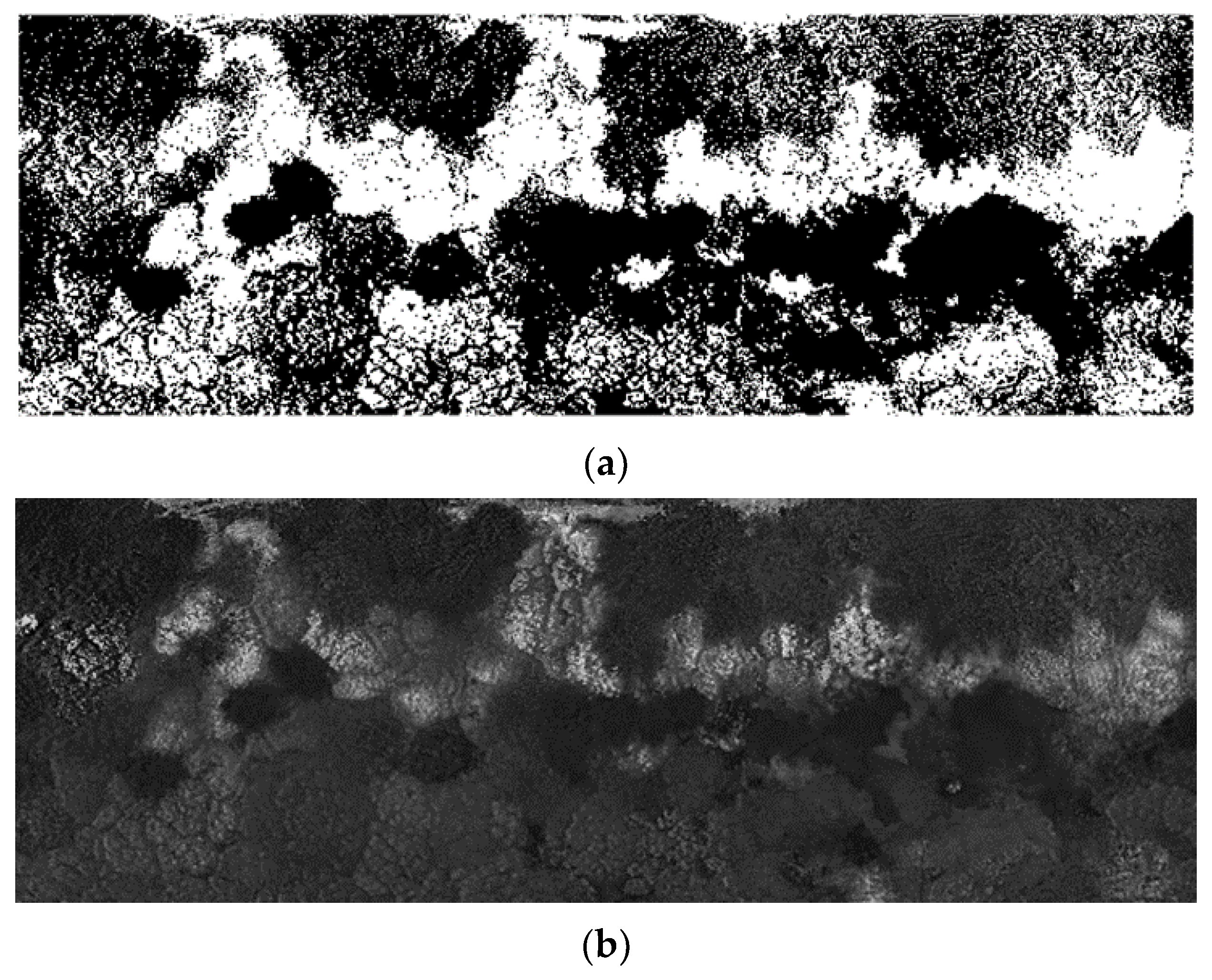
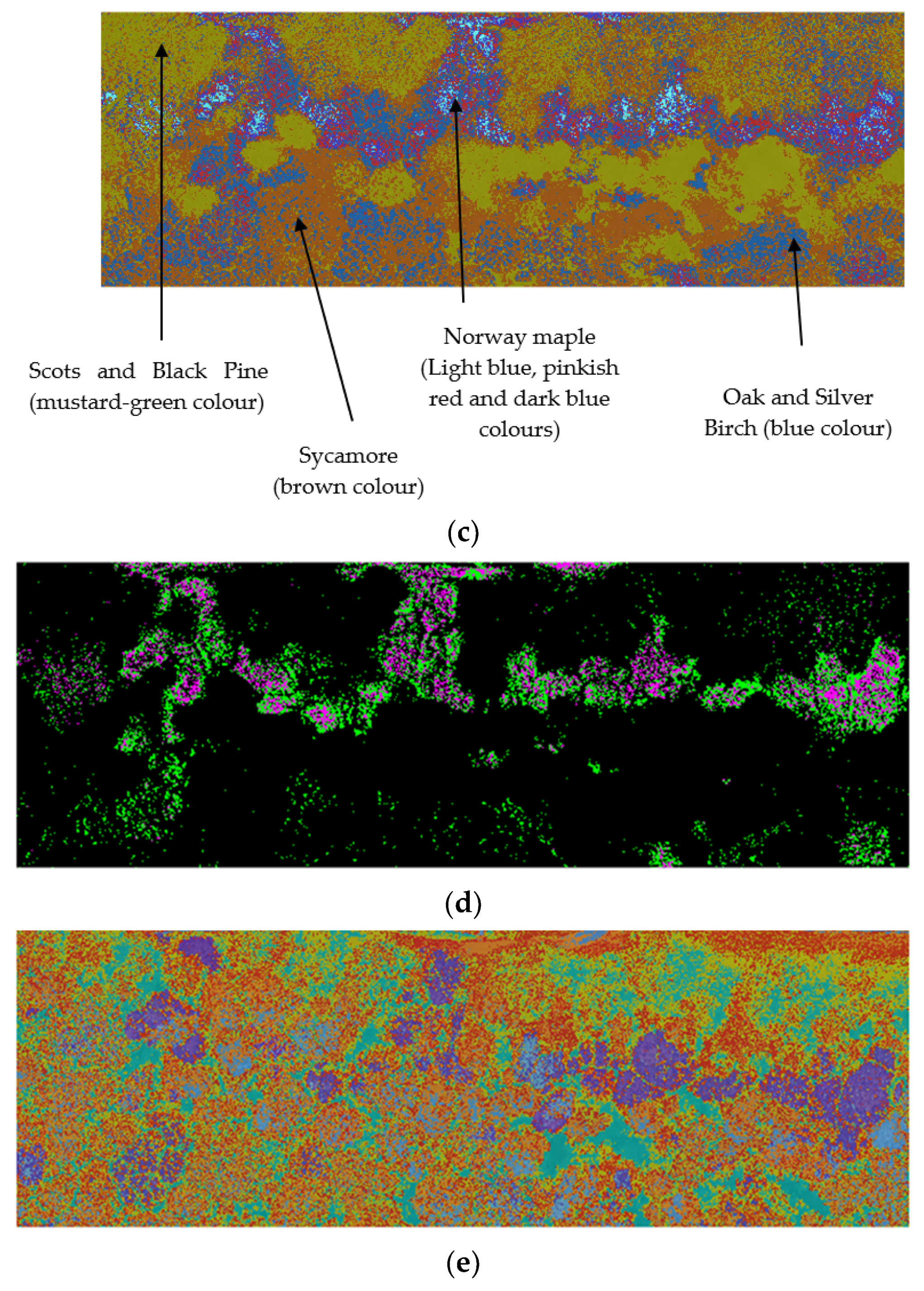
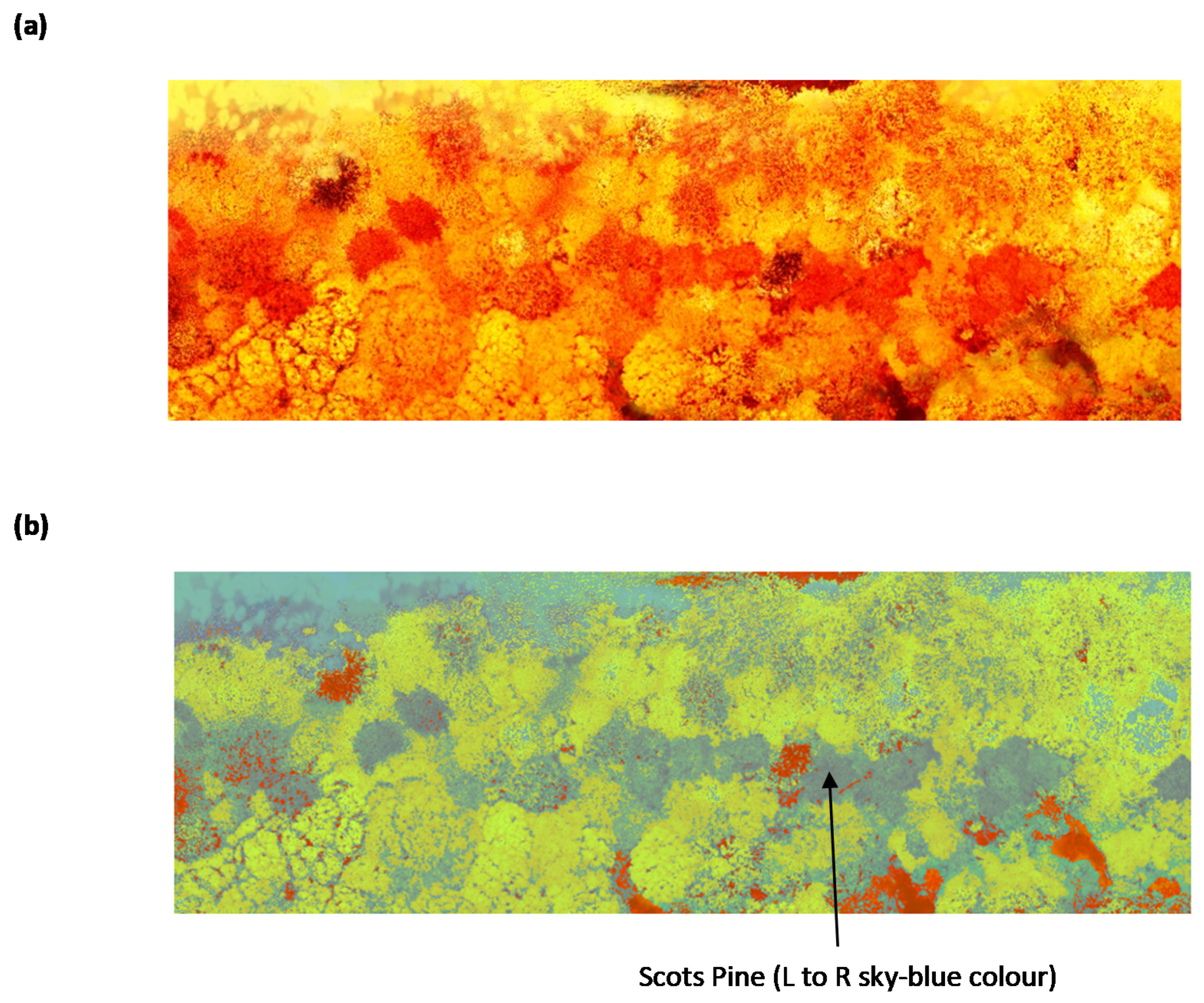

| (a) | |||||
|---|---|---|---|---|---|
| PC1 | PC2 | PC3 | PC4 | PC5 | |
| % variance | 47.435 | 26.570 | 12.801 | 8.599 | 4.595 |
| % cumulative | 47.435 | 74.005 | 86.806 | 95.405 | 100.000 |
| (b) | |||||
| % variance | 56.222 | 21.738 | 9.592 | 7.540 | 4.908 |
| % cumulative | 56.222 | 77.960 | 87.552 | 95.092 | 100.000 |
| UAV Flight # | From Analyzed UAV Data | Field Study Data @ | |||||||||||||
|---|---|---|---|---|---|---|---|---|---|---|---|---|---|---|---|
| Total Woodland Area (m2) | Area of Norway Maple Coverage (m2) | Area of Scots Pine Coverage (m2) | Area of Black Pine Coverage (m2) | Area of Sycamore Coverage (m2) | % Norway Maple Trees | % Scots Pine Trees | % Black Pine Trees | % Sycamore Trees | % Other Trees (Oak and Silver Birch) | % Norway Maple Trees | % Scots Pine Trees | % Black Pine Trees | % Sycamore Trees | % Other Trees (Oak and Silver Birch) | |
| Value * | 8052 | 1565 | 934 | 1805 | 1493 | 19 | 12 | 23 | 19 | 27 | 30 | 10 | 26 | 14 | 20 |
| Range & | 7866–8239 | 1485–1644 | 903–964 | 1794–1817 | 1453–1533 | NA | NA | ||||||||
Publisher’s Note: MDPI stays neutral with regard to jurisdictional claims in published maps and institutional affiliations. |
© 2021 by the authors. Licensee MDPI, Basel, Switzerland. This article is an open access article distributed under the terms and conditions of the Creative Commons Attribution (CC BY) license (https://creativecommons.org/licenses/by/4.0/).
Share and Cite
Ahmed, S.; Nicholson, C.E.; Muto, P.; Perry, J.J.; Dean, J.R. The Use of an Unmanned Aerial Vehicle for Tree Phenotyping Studies. Separations 2021, 8, 160. https://doi.org/10.3390/separations8090160
Ahmed S, Nicholson CE, Muto P, Perry JJ, Dean JR. The Use of an Unmanned Aerial Vehicle for Tree Phenotyping Studies. Separations. 2021; 8(9):160. https://doi.org/10.3390/separations8090160
Chicago/Turabian StyleAhmed, Shara, Catherine E. Nicholson, Paul Muto, Justin J. Perry, and John R. Dean. 2021. "The Use of an Unmanned Aerial Vehicle for Tree Phenotyping Studies" Separations 8, no. 9: 160. https://doi.org/10.3390/separations8090160
APA StyleAhmed, S., Nicholson, C. E., Muto, P., Perry, J. J., & Dean, J. R. (2021). The Use of an Unmanned Aerial Vehicle for Tree Phenotyping Studies. Separations, 8(9), 160. https://doi.org/10.3390/separations8090160






